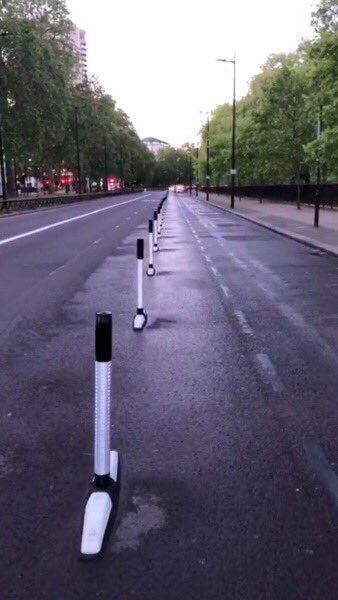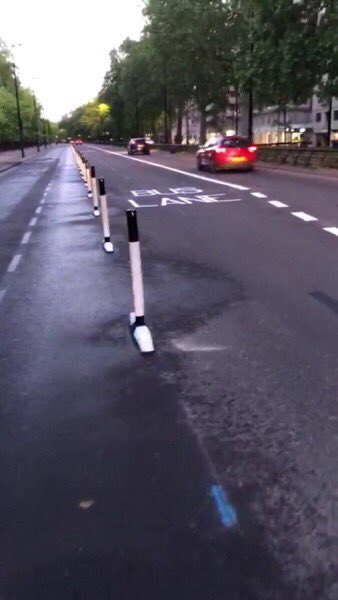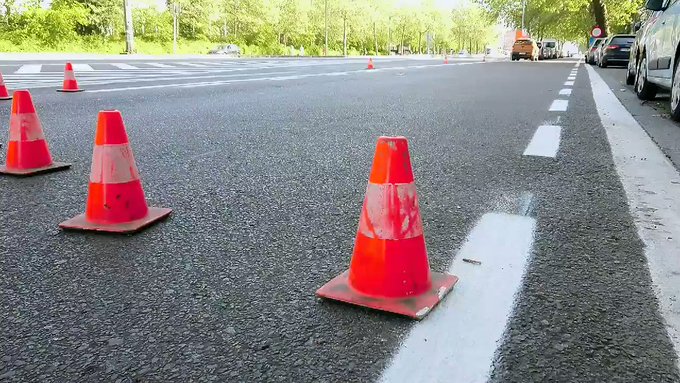/cdn.vox-cdn.com/uploads/chorus_image/image/66796882/1224717808.jpg.0.jpg)
Returning to a car-dominated city after the pandemic lockdown is ‘out of the question’By Thomas Ricker and Andrew J. Hawkins May 14, 2020, 10:14am EDT
Cities around the world are grappling with the same issue: how to safely reopen in the COVID-19 era. Public transportation systems in places like New York, London, and Paris typically carry millions of people to work and to shops each day, amounting to roughly 1.5 billion trips each year. Now, nobody wants to be on a crowded subway and risk exposure to the virus if they can avoid it. But if everyone jumps into cars instead, traffic will grind to a halt, interfere with emergency vehicles, and reverse advances many cities made toward reducing carbon emissions during lockdown. That’s why city planners and residents alike are looking at the humble bicycle as their way out.
Bicycles are the ideal mode of transportation as cities emerge from quarantine, made even more appealing now that summer is approaching in the US and Europe. They’re fast, comfortable, convenient, and allow you to socially distance while being active. When paired with an electric motor, e-bikes can make even long commutes a relaxing and sweat-free experience. They also help maintain the dramatic air quality improvements seen in cities around the world since coronavirus confinements began.
In some US cities, multilane roads and car parking can take up 50 to 60 percent of all real estate. In addition to robbing residents of parks and other open areas, it makes social distancing on congested sidewalks nearly impossible. What better time to rethink transportation models and reclaim space allocated to CO2-belching vehicles from a bygone age?
If not now, when?
How to buy an electric bike
Now is a great time to buy an e-bike
Initially, some companies saw traditional bicycle and e-bike sales dampened as the global supply chain was disrupted by lockdown orders and bike stores were forced to close. But now, sales are booming globally, with many buyers opting for electric bikes for the first time.
In Germany, for example, sales dropped by 20 to 30 percent in the first weeks of April due to bike store closures. But now that they’ve reopened, bike shops are reporting a sudden burst of sales, according to bike-eu, with e-bikes outpacing regular bikes as people move from leisure-only buying to daily use.
The same thing happened in the US, said Ryan Citron, senior research analyst at Guidehouse. “E-bike sales initially got hit pretty hard during lockdowns since many retail stores were closed down,” Citron said in an email to The Verge. “However, since bike shops have reopened, sales have been increasing rapidly.” If stores can stay open, Citron expects e-bike sales to keep in line with previous forecasts or slightly surpass them by the end of the year “as consumers look for more personal mobility options and physically distanced transport in the age of COVID.”
Matt Powell, senior industry advisor for the NPD Group, told The Verge that US retail sales of e-bikes in the first quarter of 2019 grew 90 percent year over year.
:no_upscale()/cdn.vox-cdn.com/uploads/chorus_asset/file/19970151/_C0A4425.jpg)
Some of the most popular e-bike companies say they are seeing these trends reflected in their sales receipts.
Brompton, the London-based maker of iconic folding bikes, saw UK online sales from both accredited retailers and via Brompton.com grow rapidly — five times higher than the previous month — even as global sales fell over the last two months compared to the year earlier. In the last three weeks, though, the company saw record-breaking sales in China as travel restrictions were lifted. Brompton’s website traffic has been through the roof, especially in the US where the company has seen an “incredible surge in interest,” according to a statement sent to The Verge.
UK-based Gocycle saw a sales bump despite an interruption to its dealer network of stores. Sales of its fast-folding Gocycle GX e-bike are up 65 percent in the last six weeks compared to the same period in 2019, the company told The Verge, with traffic to its gocycle.com website up 90 percent. The company attributes the growth to changing commuter habits in response to the pandemic.“COVID IS PULLING THE [E-BIKE] ADOPTION CURVE FORWARD.”
“Smart commuters are investing for the long term and going for e-bikes,” said Gocycle founder Richard Thorpe. “We have seen sales of our fast-folding Gocycle GX range rocket upwards within the last few weeks — literally at a rate 4x in urban areas compared with this time last year. COVID is pulling the adoption curve forward.”
Dutch e-bike maker VanMoof sells bikes online and through its own brand stores, bypassing traditional bike stores completely. It says that sales from February to April were up dramatically compared to the same period last year. Sales increased in all its main markets, including Germany (+226 percent), the UK (+184 percent), the Netherlands (+140 percent), the US (+138 percent), and France (+92 percent). The uptick was at least partially driven by discounts ahead of the launch of its S3 and X3 e-bikes in April.
US bike retailer Lectric eBikes reported a 140 percent increase in sales since March 15th. “Our customers have been saying that e-bikes are a great option for the new coronavirus-era way of living,” said co-founder Levi Conlow to Electrek. “The dramatic increase in sales shows that nationally, people are looking to shift how they get around.”
Seattle-based Rad Power Bikes said its sales in April increased a whopping 297 percent year over year, vastly exceeding the company’s expectations. The company’s sales to business customers in the delivery sector also rose 191 percent from March to April this year, a spokesperson said.
Aventon Bikes, based in Ontario, California, claims to be flooded with orders, with sales up in Massachusetts (+298 percent), California (+85 percent), and New York (+164 percent). “We have been busier than ever, we are literally breaking records daily on orders and sales,” Adele Nasr, chief marketing officer for Aventon, said in an email.
Globally, Google notes a spike in searches for “best electric bike” starting on March 22nd, less than two weeks after the World Health Organization declared the new coronavirus a pandemic. Even more people began searching for “best bike” during the same period.
An influx of new bicycles will need infrastructure to keep those riders safe. It won’t happen overnight, but even bike-friendly cities like Amsterdam — where roughly half of all commutes occur by bicycle — had to start somewhere.
The UK is leading the transformation by committing hundreds of millions of pounds to make cities more bike-friendly while urging the public to avoid public transportation. A £250 million (about $300 million) emergency fund has been carved out of a £2 billion cycling and walking package to create new bike lanes and safer junctions “within weeks.” Towns and cities have already been told to reallocate road space “for significantly-increased numbers of cyclists and pedestrians.” E-scooters are currently illegal in the UK, but trials are being accelerated from next year to next month to possibly change that.
:no_upscale()/cdn.vox-cdn.com/uploads/chorus_asset/file/19970149/Streetspace_Brixton_2_medium.jpg)
British Transport Secretary Grant Shapps argues that alternative modes of transportation will have both short- and long-term benefits well after the pandemic subsides:
During this crisis, millions of people have discovered cycling — whether for exercise or as a means of safe, socially-distanced transport. While there is no change to the ‘stay at home’ message today, when the country does get back to work we need those people to stay on their bikes and be joined by many more.
Otherwise, with public transport’s capacity severely restricted at this time, our trains and buses could become overcrowded and our roads gridlocked – holding up emergency services, critical workers and vital supplies.
We know cars will continue to remain vital for many, but as we look to the future we must build a better country with greener travel habits, cleaner air and healthier communities.


894Twitter Ads info and privacy264 people are talking about this
Last week, London Mayor Sadiq Khan and Transport for London (TfL) launched the Streetspace program that will transform London streets to accommodate an expected tenfold increase in cycling and fivefold increase in walking as lockdown restrictions are relaxed. Much of the work is temporary but could become permanent, according to TfL.
Other European cities have kicked off similar initiatives. Milan, one of the most polluted cities in Europe, plans to convert 22 miles (35 km) of streets into cycling and walking space over the summer as COVID-19 restrictions are lifted. The city’s plan includes temporary cycle lanes, new and wider sidewalks, lower 20 mph (30 kph) speed limits, and streets where bicyclists and pedestrians take priority over cars.
“We worked for years to reduce car use. If everybody drives a car, there is no space for people, there is no space to move, there is no space for commercial activities outside the shops,” said deputy mayor of Milan Marco Granelli in comments reported by The Guardian. “Of course, we want to reopen the economy, but we think we should do it on a different basis from before.”Tudor ALEXIS✔@tudoralexis1
France will see over 1000 kms of temporary bike lanes sprouting in the next weeks! Even in rural areas! @jen_keesmaat @RobinMazumder https://www.ouest-france.fr/economie/entretien-va-depasser-les-1-000-km-de-pistes-cyclables-temporaires-6829907 …ENTRETIEN. « On va dépasser les 1 000 km de pistes cyclables temporaires »Pierre Serne est président du Club des villes et territoires cyclables. Sollicité par le ministère des Transports, le club aide les collectivités territoriales pour développer l’usage du vélo pendant…ouest-france.fr137Twitter Ads info and privacy49 people are talking about this
France is installing temporary bike lanes in cities nationwide. Paris plans to open up 400 miles of pop-up bike lanes and will convert its biggest cross-city through route into a bike-only highway. Mayor Anne Hidalgo, a bicycling advocate long before the pandemic, said that the idea of Paris returning to a car-dominated city is “out of the question.”
“I say in all firmness that it is out of the question that we allow ourselves to be invaded by cars, and by pollution,” said Hidalgo, according to CityLab. “It will make the health crisis worse. Pollution is already in itself a health crisis and a danger — and pollution joined up with coronavirus is a particularly dangerous cocktail. So it’s out of the question to think that arriving in the heart of the city by car is any sort of solution, when it could actually aggravate the situation.”Mathieu Chassignet@M_Chassignet

Brussels, the de facto capital of the European Union, is adding some 25 miles (40km) of bike lanes. “We know two-thirds of trips within Brussels are less than three miles. We want, then, to encourage healthy people to walk or to bike,” said transport minister Elke Van den Brandt to Belgium’s Le Soir newspaper. “And for that, it’s our responsibility to have secured infrastructures.”
In the US, a number of major cities have outlined plans to close streets to car traffic in an effort to provide safe space for socially distanced walking and biking. And some are going a step further by making them permanent.
Seattle recently announced that it would close 20 miles of streets to most traffic permanently. “[The pedestrianized streets] are an important tool for families in our neighborhoods to get outside, get some exercise and enjoy the nice weather,” Seattle Mayor Jenny Durkan said in a statement. “Over the long term, these streets will become treasured assets in our neighborhoods.”“OVER THE LONG TERM, THESE STREETS WILL BECOME TREASURED ASSETS IN OUR NEIGHBORHOODS.”
In April, Oakland said it would begin gradually pedestrianizing roadways, with the goal of closing 74 miles to most vehicles or about 10 percent of the city’s streetscape. Denver has designated 13 miles of open streets, while Minneapolis set aside 18 miles for pedestrians and cyclists. Boston is considering using street space for bike lanes, wider sidewalks, and faster bus routes.
New York City, which has seen a dramatic drop in vehicular traffic, opened 12 miles of roadways to pedestrians this week and added nine more miles of protected bike lanes. That was in addition to the nine miles of roads that have been closed to cars since early May. NYC Mayor Bill de Blasio, who is frequently criticized for his use of a city-owned SUV, has said his goal is for a total of 100 miles of open streets.
New York recently legalized electric bikes, which was a boon to immigrant food delivery workers who largely rely on e-bikes for work. New York City still needs to outline a regulatory scheme for the newly legal vehicles, but e-bike makers expect sales in the city to skyrocket for city-dwellers looking for speedy ways to get around without using public transportation or ride-share vehicles.
Biking has already exploded across the US since the lockdown went into effect, according to recent data. Eco-counter, which collects bike data, says that cycling is up 5 percent in North America compared to usual. Multiple regions in the US are up over 100 percent on weekends alone.
Meanwhile, vehicular traffic has plummeted, and the air is getting easier to breathe. There was a nearly 19 percent drop in vehicle miles traveled on all roads and streets in the US in March as compared to the same month last year, according to federal data. As noted by transportation researcher Yonah Freemark, that’s 50.6 billion fewer vehicular miles in March compared to the baseline. And with the average US fuel economy of 22.3 mpg, that’s around 45 billion pounds of CO2 that were not emitted, Freemark says.
It’s a remarkable transformation, but it could all be undone if cities aren’t bold in how they reimagine their streetscapes.
:no_upscale()/cdn.vox-cdn.com/uploads/chorus_asset/file/19913095/verge_DSC_7394_2040pxl.jpg)
Amsterdam wasn’t always a world-class bicycle city. In the early 1970s, cars dominated the streets. It took years of fierce activism and enlightened policymakers unencumbered by the desires of entrenched automobile interests for the city to realize that cars weren’t the future of urban transport.
Now bikes permeate the culture, making them as Dutch as wooden shoes and tulips. Everyone from toddlers to the elderly enjoys the freedom and security of protected bike lanes and the byproduct of smog-free air. Yes, Amsterdam is flat, making it ideal for bicycling. But electric bikes can flatten a San Francisco hill like stay-at-home orders can flatten an infection curve.
Unfortunately, many of the COVID-19-era transportation measures being rolled out by cities are being done so timidly, often behind the guise of temporary change — under the assumption, perhaps, that the world will return to normal quickly after lockdowns are lifted. Verge readers will know, however, that that’s wishful thinking.
Or maybe it’s sly politics, easing inhabitants into a new urban transportation reality.
